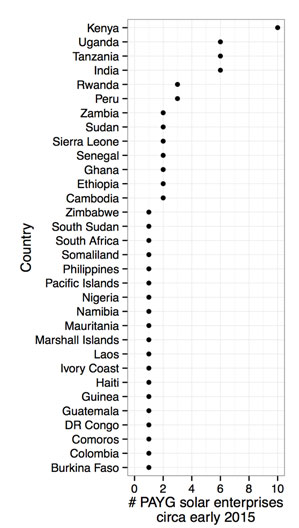Mobile Money Catalyzes Clean Energy Uptake among Off-Grid Consumers
 Mobile money is dramatically accelerating uptake of clean energy solutions among cash-strained off-grid consumers in developing countries, according to a new study by the IFC/World Bank Lighting Global program.
Mobile money is dramatically accelerating uptake of clean energy solutions among cash-strained off-grid consumers in developing countries, according to a new study by the IFC/World Bank Lighting Global program.
By providing financing and increasing connectivity throughout the supply chain, mobile money has led to the birth of pay-as-you-go (PAYG) business models that are enabling off-grid consumers take up modern energy solutions, notably solar lighting products, with greater ease.
One PAYG provider involved with the study reported a doubling to tripling of sales of solar lighting products sold through PAYG, compared to outright cash sales.
“It is an exciting time in the market!” says Peter Alstone, lead author of the study. “PAYG offers customers financing that they need to purchase solar, and also builds trust, overcoming two key barriers to energy access.”
The study, Off-Grid Power and Connectivity; Pay-As-You-Go Financing and Digital Supply Chains for Pico-Solar, was undertaken in 2014 with a focus in Kenya, also the pilot country for the acclaimed IFC/World Bank Lighting Africa program, now operational in over 10 countries.
The in-depth analysis found that about15% of customers in one PAYG model paid for their purchase in full in less than 30 days, versus the available 70 loan days, strengthening the assertion that some buyers were using PAYG to overcome product trust barriers,over and above the finance barrier.
The study established that mobile connectivity can burgeon successful delivery of good quality and trusted off-grid energy systems to retail markets.
The market for PAYG solar is fast growing, now present in more than 30 countries. It constitutes a wide range of approaches to payments, and business models. Some business models are DESCOs – distributed energy service companies, which provide access to energy services in exchange for ongoing payments. Others are better described as asset finance or micro-loan providers, who transfer ownership of the energy asset (solar lantern) to the buyer upon completion of payments over limited periods of time.
Connectivity also varies significantly including systems with embedded GSM (mobile phone machine-to-machine transfer) modules and mobile money payment systems as well as those which use top-up scratch cards and remote keypads. GSM technology allows PAYG providers to monitor and respond to changes in system performance, improving service reliability and durability of energy access.
“PAYG solar doesn’t just help to boost uptake; it also allows many providers to have more direct interactions with customers, providing an ongoing channel for after sales service, payment reminders, and other information via SMS,” the study notes.
Investment in the PAYG sector is however currently insufficient to fulfill capital needs for providers. Although more than $70m of equity and debt investment in PAYG firms has been publicly announced, the Global Off-Grid Lighting Association (GOGLA) estimates a sector-wide need of over $1.5b to support consumer finance over the next two years.

